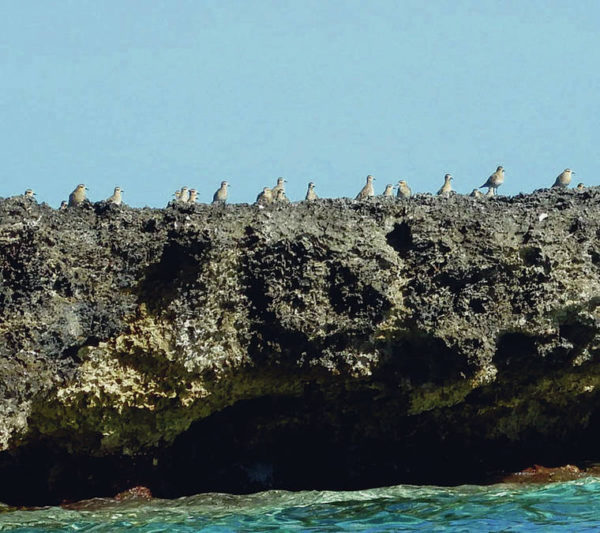Published in the Ocean Watch column, Honolulu Star-Advertiser © Susan Scott
January 11, 2020
MIDWAY ATOLL >> Midway is a typical atoll, consisting of three sand islands inside a turquoise lagoon encircled by coral reef. During the 1940s the Navy built a recreational hut on metal pilings near the inner reef edge, about 5 miles from the boat harbor. Nicknamed the Reef Hotel, the structure is long gone, but its supports remain, attracting fish and, therefore, snorkelers.
Last week, with the albatross count nearly finished, the U.S. Fish and Wildlife Service managers treated us volunteers to a snorkeling excursion near the Reef Hotel. We didn’t expect to see anything above the water besides rusting pillars and wave-battered reef walls. But as often happens, nature surprised us.
 Kolea lined up on the reef wall at Midway Atoll.
Kolea lined up on the reef wall at Midway Atoll.
©2020 Susan Scott
Underwater, of course, we found reef fish galore, and given that there hasn’t been fishing in this wildlife refuge for decades, these fish weren’t afraid of us. We Hawaii residents were thrilled to swim with several species of 2-foot-long parrotfish, their reds, blues and greens flashing in the sun as they grazed about the shallow reef.
Squirrelfish with enormous black eyes peeked out from coral caves, giving us glimpses of their sparkling red and silver stripes. Several enormous unicornfish passed by, but I missed them because surrounding me at that moment were a dozen or so big, bold trevally, known as omilu.
But the highlight of the day came when we approached the exposed reef rising some 6 feet or so above the water, waves breaking on the outside, calm lagoon on the inside. And there, to our astonishment, standing on the coral clifftop, were hundreds of Pacific golden plovers, the shorebirds we call kolea.
We albatross counters have a wide range of experience with bird species, but no one knew why a large flock of kolea would be hanging out on a reef rise miles from land.
Kolea are common here on Midway, but these aren’t the people-friendly types we see on the main islands. I’ve spent hours trying to get pictures of Midway’s plovers, even hiding in camouflaged clothing inside a naupaka bush with a telephoto lens.
After sitting motionless for about 20 minutes, I peeked out only to find the several kolea I was trying to photograph watching me from the distant breakwater, fully aware of my presence. My movement of the bush’s leaves set them flying.
A few kolea forage on the grassy lawns of the houses and other structures of Midway’s main island. If I keep walking on the road, the plovers continue eating. But if I stop to admire one, its little head pops up, and it winds its way through the nesting albatrosses until it’s out of sight.
On Oahu, when I see these delicate-looking shorebirds prancing around our manicured lawns, they don’t strike me as oceanic. But these hardy little birds are quite at home in the winds, waves and reefs of the Pacific Ocean. It took a snorkeling trip on Midway to remind me.